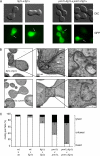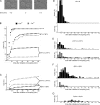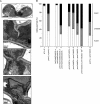The plasma membrane proteins Prm1 and Fig1 ascertain fidelity of membrane fusion during yeast mating
- PMID: 17151357
- PMCID: PMC1783792
- DOI: 10.1091/mbc.e06-09-0776
The plasma membrane proteins Prm1 and Fig1 ascertain fidelity of membrane fusion during yeast mating
Abstract
As for most cell-cell fusion events, the molecular details of membrane fusion during yeast mating are poorly understood. The multipass membrane protein Prm1 is the only known component that acts at the step of bilayer fusion. In its absence, mutant mating pairs lyse or arrest in the mating reaction with tightly apposed plasma membranes. We show that deletion of FIG 1, which controls pheromone-induced Ca(2+) influx, yields similar cell fusion defects. Although extracellular Ca(2+) is not required for efficient cell fusion of wild-type cells, cell fusion in prm1 mutant mating pairs is dramatically reduced when Ca(2+) is removed. This enhanced fusion defect is due to lysis. Time-lapse microscopy reveals that fusion and lysis events initiate with identical kinetics, suggesting that both outcomes result from engagement of the fusion machinery. The yeast synaptotagmin orthologue and Ca(2+) binding protein Tcb3 has a role in reducing lysis of prm1 mutants, which opens the possibility that the observed role of Ca(2+) is to engage a wound repair mechanism. Thus, our results suggest that Prm1 and Fig1 have a role in enhancing membrane fusion and maintaining its fidelity. Their absence results in frequent mating pair lysis, which is counteracted by Ca(2+)-dependent membrane repair.
Figures






References
-
- Chen E. H., Olson E. N. Unveiling the mechanisms of cell-cell fusion. Science. 2005;308:369–373. - PubMed
-
- Duzgunes N., Wilschut J., Fraley R., Papahadjopoulos D. Studies on the mechanism of membrane fusion. Role of head-group composition in calcium- and magnesium-induced fusion of mixed phospholipid vesicles. Biochim. Biophys. Acta. 1981;642:182–195. - PubMed
-
- Ellens H., Bentz J., Szoka F. C. H+- and Ca2+-induced fusion and destabilization of liposomes. Biochemistry. 1985;24:3099–3106. - PubMed
Publication types
MeSH terms
Substances
LinkOut - more resources
Full Text Sources
Molecular Biology Databases
Research Materials
Miscellaneous

